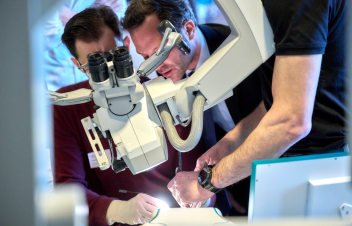How Does Vascular Surgery Help Treat Aneurysms and Blood Clots?
- surgeonslab1
- Nov 28, 2024
- 4 min read

Vascular surgery is a specialty that treats disorders of the vascular system, including arteries, veins, and lymphatic vessels. This field covers a variety of vascular conditions, ranging from aneurysms to blood clots. Recently, endovascular simulators have improved our skills and techniques. This article reviews the surgery's scope and highlights the importance of new technologies in treating life-threatening conditions.
Understanding Aneurysms and Blood Clots
Let us first understand what aneurysms and blood clots are before moving on to the role of vascular surgery:
Aneurysms
Weakened blood vessel walls can form aneurysms. These bulges often occur in the brain and limbs. If untreated, they may burst, causing severe problems like a hemorrhagic stroke or internal bleeding. Despite being small, these vascular issues need careful monitoring. Early detection and treatment can prevent serious outcomes. This is crucial for saving lives and limbs. Knowing symptoms and risk factors helps people seek timely care, potentially avoiding disasters.
Blood Clots
When veins or arteries clog, danger lurks. Deep Vein Thrombosis often strikes leg veins, while arterial clots trigger strokes or lung blockages. These blood flow obstructions, born from abnormal clotting, pose grave health risks. Understanding thrombosis - its origins and impacts - is crucial for heart health and averting dire consequences. Vigilance against blood clots safeguards our circulatory system's vital flow.
Vascular Surgery: A Lifesaving Approach
Vascular surgeons treat aneurysms and blood clots, saving lives. Their methods increase survival and improve well-being. By fixing circulatory problems, they offer hope and a better quality of life. Here is how vascular surgery helps in managing these conditions:
Treating Aneurysms:
Open Surgical Repair
In conventional vascular surgery, open surgical repair is applied to manage aneurysms. It entails making an incision over the compromised region exposing the aneurysm; then, substituting the compromised portion of the vessel using a synthetic graft. Traditionally, open surgery has remained a reliable mode for the management of aneurysm, with good outcomes and durability lasting long.
Endovascular Repair
Thus, technology has improved tremendously, and endovascular repair nowadays has become an easily preferred alternative to open surgery. It initiates in situ with the catheter placement through a small incision made in the groin and then advances under high magnification directly to the aneurysm. A narrow fabric tube reinforced by metal mesh serves as a stent graft, reinforcing the weakened vessel and driving the bloodstream away from the aneurysm.
Endovascular Simulators
The advent of endovascular simulators, including SurgeonsLab, has maximally altered the practice maximally. Such endovascular simulators offer a very real and immersive training space in which surgeons can hone their skills at doing endovascular procedures without any risk. Simulating an aneurysm allows surgeons to build up their skills and decision-making capacity and minimize complications from real surgeries.
Managing Blood Clots
Thrombolytic Therapy: Vascular surgeons may use thrombolytic drugs that dissolve blood clots. Intravenous use or direct infusion into the clot is used to dissolve it and restore blood flow, thereby broken up. The effectiveness of thrombolytic therapy lies in its treatment capabilities for DVT and the prevention of pulmonary embolism complications.
Mechanical Thrombectomy: Mechanical thrombectomy is performed in cases of higher amplitude or large clots. The procedure employs specialized equipment to manually remove the clot from the targeted vessel. In cases where clots are inaccessible, endovascular interventions—like catheter-directed thrombolysis or mechanical clot aspiration—may be required to gain access and treat them.
Vascular Bypass Surgery: Bypass surgery treats blood vessel clots by redirecting blood flow. A vascular surgeon uses grafts or the patient's veins to bypass blockages. This procedure restores blood flow and eases symptoms. Essentially, it improves vascular function by avoiding problematic areas.
Middle Meningeal Artery Techniques
Of course, such potential interest drawn by vascular surgery to the Middle Meningeal Artery techniques has been raised in relation to its use for managing some conditions like chronic subdural hematomas and even traumatic brain injuries. Here is how vascular surgery techniques involving the MMA can help:
MMA Embolization
This technique is used to treat chronic subdural hematomas, also called collections of blood that gather on the brain's surface. With selective obliteration of the MMA for embolization, surgeons can cut off the blood supply to the hematoma, which can then be reabsorbed, and recurrence is avoided. This minimally invasive procedure utilizes endovascular techniques, thus making it safer and less invasive compared to traditional surgical methods in cases of traumatic brain injuries.
MMA Decompression
It is definitely more beneficial. During surgical procedures for MMA decompression, a surgeon opens the MMA to relieve any increase in intracranial pressure. When the pressure around the brain is eased through this procedure, outcomes are better for patients, and recovery processes may be supported.
To Sum Up
Vascular surgery controls aneurysms and blood clots to a great degree. This treatment is also diversified, providing even better results for patients. Surgeons now use advanced simulators and techniques, like MMA embolization and decompression, to better tackle vascular diseases. With ongoing technological progress, the future of vascular surgery looks bright. Thanks to these advancements, patients with circulatory issues can anticipate better care and improved quality of life.







